
An overview of Adding an event listener
- Subject:
- Computer Science
- Information Technology
- Life Science
- Physical Science
- Material Type:
- Interactive
- Lesson
- Provider:
- Khan Academy
- Provider Set:
- Khan Academy
- Author:
- Pamela Fox
- Date Added:
- 08/10/2021

An overview of Adding an event listener

Learn how to add event listeners in jQuery so that your JavaScript can respond to events on the page, like when a user clicks a button or drags an image.

" This is a graduate course on the design and analysis of algorithms, covering several advanced topics not studied in typical introductory courses on algorithms. It is especially designed for doctoral students interested in theoretical computer science."

Following a brief classroom discussion of relevant principles, each student completes the paper design of several advanced circuits such as multiplexers, sample-and-holds, gain-controlled amplifiers, analog multipliers, digital-to-analog or analog-to-digital converters, and power amplifiers. One of each student's designs is presented to the class, and one may be built and evaluated. Associated laboratory emphasizing the use of modern analog building blocks. Alternate years.

Materials covered include: special relativity, electrodynamics of moving media, waves in dispersive media, microstrip integrated circuits, quantum optics, remote sensing, radiative transfer theory, scattering by rough surfaces, effective permittivities, and random media.

The purpose of this tutorial (along with the “Advanced Keyword Searching, Part I” tutorial) is to help the student master comprehensive, keyword searching. Performing a truly comprehensive, keyword search is more difficult than performing a similarly thorough, subject heading search. We hope that this tutorial will make the steps involved in this complex process easier to understand and master.

This course is a graduate introduction to natural language processing - the study of human language from a computational perspective. It covers syntactic, semantic and discourse processing models, emphasizing machine learning or corpus-based methods and algorithms. It also covers applications of these methods and models in syntactic parsing, information extraction, statistical machine translation, dialogue systems, and summarization. The subject qualifies as an Artificial Intelligence and Applications concentration subject.

Recent results in cryptography and interactive proofs. Lectures by instructor, invited speakers, and students. Alternate years. The topics covered in this course include interactive proofs, zero-knowledge proofs, zero-knowledge proofs of knowledge, non-interactive zero-knowledge proofs, secure protocols, two-party secure computation, multiparty secure computation, and chosen-ciphertext security.
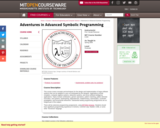
" This course covers concepts and techniques for the design and implementation of large software systems that can be adapted to uses not anticipated by the designer. Applications include compilers, computer-algebra systems, deductive systems, and some artificial intelligence applications. Topics include combinators, generic operations, pattern matching, pattern-directed invocation, rule systems, backtracking, dependencies, indeterminacy, memoization, constraint propagation, and incremental refinement. Substantial weekly programming Assignments and Labs are an integral part of the subject. There will be extensive programming Assignments and Labs, using MIT/GNU Scheme. Students should have significant programming experience in Scheme, Common Lisp, Haskell, CAML or some other "functional" language."

Some advice from our storytellers.
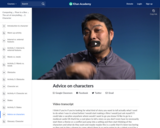
More advice to new writers.
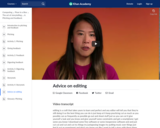
Advice on editing.
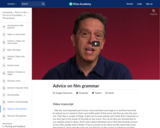
Advice for storytellers.
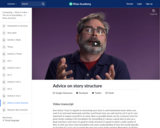
Advice from storytellers on structure.
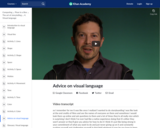
Advice from our storytellers.
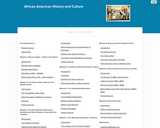
African American History and Culture contains 10 modules starting with African Origins - History and Captivity and continuing through Reconstruction. Openly-licensed course materials developed for the Open Educational Resources (OER) Degree Initiative, led by Achieving the Dream https://courses.lumenlearning.com/catalog/achievingthedream.
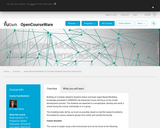
Building on Complex Adaptive Systems theory and basic Agent Based Modeling knowledge presented in SPM4530, the Advanced course will focus on the model development process. The students are expected to conceptualize, develop and verify a model during the course, individually or in a group. The modeling tasks will be, as much as possible, based on real life research problems, formulated by various research groups from within and outside the faculty.
Study Goals The main goal of the course is to learn how to form a modeling question, perform a system decomposition, conceptualize and formalize the system elements, implement and verify the simulation and validate an Agent Based Model of a socio-technical system.

How to combine data from a database using SQL.

This lesson centers around the How AI Works: Equal Access and Algorithmic Bias video from the How AI Works video series. Watch this video first before exploring the lesson plan.
In this lesson, students will practice cropping images to uncover the bias underlying the Twitter cropping algorithm. Then, students will read and watch a video about the discovery of this biased algorithm. Finally, students will discuss ways to recognize and reduce bias along with analyzing Twitter's response to the allegations of bias in their cropping algorithm.
This lesson can be taught on its own, or as part of a 7-lesson sequence on How AI Works. Duration: 45 minutes
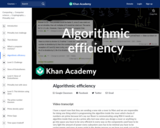
How can we improve the speed of a (deterministic) primality test? Created by Brit Cruise.